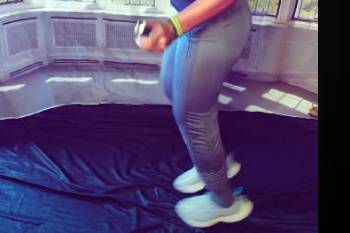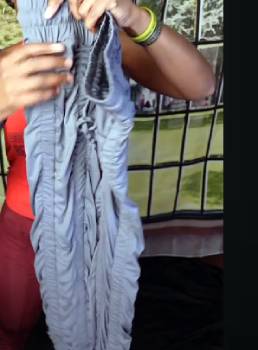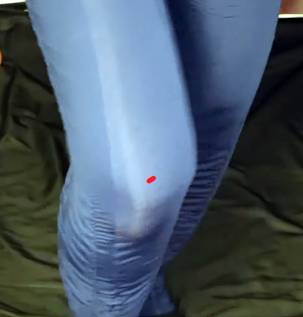I can’t recommend resistance band leggings, despite their $30 price and calorie-burning claims. The concept—leggings with built-in bands to tone legs—sounds amazing, but my experience fell flat. These 79% polyester, 21% spandex pants promise workouts in every step, but issues like poor fit and weak resistance disappoint. In this article, I’ll share my journey, pros, cons, maintenance tips, and comparisons to other brands. Save your money and explore better options for your fitness goals.
My Experience With Resistance Band Leggings

Alright, let me walk you through my experience with those intriguing resistance band leggings I spotted on Amazon for a tempting $30.
As a busy mom of two, constantly juggling work responsibilities and daily walks with my energetic dog, the promise of effortlessly burning extra calories just by wearing leggings while tackling errands or flowing through a yoga session sounded like the ultimate fitness hack – a way to sneak in some extra muscle engagement without dedicating extra time.
The fabric composition, a blend of 79% polyester and 21% spandex, boasted compression, tummy control, and the muscle-toning benefits of built-in resistance. Based on the sizing chart, I opted for an XL, anticipating a snug and supportive fit for my size 12 frame, with the added hope that they might provide some gentle support for my post-injury knee swelling and subtly boost the intensity of my regular workouts.
When the leggings finally arrived, I was genuinely excited to try them on. The sleek black design with the high waistband and subtle lines indicating the resistance bands looked promising.
However, the initial experience of trying to put them on was surprisingly challenging. The waistband, despite being an XL, felt incredibly tight and restrictive as I tried to pull it over my hips – it honestly felt like it was two sizes too small.
Yet, paradoxically, once I managed to get them on, the legs felt oddly loose and not particularly compressive. I decided to wear them for my usual 2-mile walk with the dog, fully expecting to feel some noticeable resistance with each step. To my disappointment, the resistance was barely perceptible, feeling almost indistinguishable from wearing a regular pair of non-compression leggings.
My knees didn’t feel any additional support, and the tightly constricting waistband dug uncomfortably into my stomach, leaving visible red marks by the end of the walk.
Over the next three days, I tried incorporating these resistance band leggings into my yoga practice and while doing chores around the house, hoping that perhaps I would notice the resistance more during different types of movements. Unfortunately, the results remained underwhelming. I experienced no noticeable muscle soreness that would indicate any significant extra effort, and I certainly didn’t feel any tangible increase in calorie burn.
To add to the frustration, the overly tight waistband had a tendency to roll down during yoga lunges, which was incredibly annoying and counterproductive. Curiously, my daughter, who wears a size 6 or 8, decided to try them on. While the waistband actually fit her comfortably, the legs were noticeably baggy and didn’t provide any of the compression or resistance benefits they were supposed to offer. After a full week of trying to make these leggings work, I was left feeling frustrated and disappointed.
My medical-grade compression leggings, specifically designed to address my hip and knee issues, provided far superior support, compression, and overall comfort. These resistance band leggings simply didn’t live up to the hype or the promises made in the product description, and ultimately, I decided to return them, thoroughly disappointed by this fitness “hack” that turned out to be more of a fashion flop.
Also read: My Thoughts On Magnilife Leg And Back Pain Relief
Pros Of Resistance Band Leggings

These leggings have some redeeming qualities, but they’re overshadowed by the flaws. Here’s what worked for me.
- Affordable Price Point: At $30, they’re budget-friendly compared to competitors like Sweetflexx ($98) or AGOGIE ($129). You’re not breaking the bank to try them, which is a plus if you’re curious.
- Decent Material Quality: The 79% polyester, 21% spandex blend is soft, moisture-wicking, and durable. They held up through washes without pilling, feeling smooth against my skin.
- Stylish Appearance: The sleek black design and high-waisted look are flattering from a distance. They pair well with long tops for casual wear, hiding the band lines.
- Easy to Clean: Machine-washable with like colors, they’re low-maintenance. I tossed them in with my workout gear, and they came out fine, no special care needed.
- Compression for Light Support: The high-waisted design offers mild tummy control, giving a slimming effect for casual outings, though it’s not as supportive as medical-grade options.
These perks are nice, but they don’t make up for the leggings’ core issues, especially for fitness-focused users.
Cons Of Resistance Band Leggings

The downsides are dealbreakers, and I ran into plenty of frustrations. Here’s why these leggings disappointed.
- Weak Resistance Effect: The built-in bands barely add resistance. I felt no extra muscle engagement during walks or yoga, unlike what’s advertised. Studies like Yale’s on Sweetflexx (255 extra calories burned daily) don’t apply here—these feel like regular leggings.
- Poor Fit and Sizing Issues: The XL was tight at the waist but loose in the legs, unfit for my size 12 body. My daughter’s medium frame had similar issues, suggesting inconsistent sizing across body types.
- Uncomfortable Waistband: The high-waisted design digs into the stomach and rolls down during movement. It left marks on my skin and felt restrictive, not supportive, especially for post-injury use.
- No Knee or Joint Support: As someone with knee swelling from a hip injury, I hoped for support, but these offered none. My medical-grade compression leggings are far superior for circulation and pain relief.
- Visible Band Lines: The resistance bands create a ruched, striped look that’s noticeable in bright light, making them less versatile for public wear unless covered by a long top.
These flaws make the leggings impractical for workouts or daily wear, falling short of their fitness promises.
Maintenance Tips For Resistance Band Leggings

If you decide to try these leggings, proper care can extend their life and keep them functional. Here’s how I managed mine.
- Wash with Like Colors: Machine-wash on a cold cycle with similar colors to prevent fading. I used a gentle detergent to protect the spandex and avoid color bleed.
- Air Dry to Preserve Elasticity: Skip the dryer—heat can weaken the spandex and bands. I hung mine on a rack to air dry, keeping the fabric stretchy and intact.
- Avoid Fabric Softener: Softener can coat the moisture-wicking fabric, reducing its effectiveness. I stuck to regular detergent to maintain the leggings’ breathability.
- Store Flat or Folded: Don’t hang them, as the weight can stretch the bands. I folded mine in a drawer to preserve the resistance bands’ shape and elasticity.
- Inspect Bands Regularly: Check for loose stitching around the bands after each wash. I noticed slight fraying early, so reinforcing seams with a needle can prevent damage.
- Spot Clean Stains: For sweat or dirt, spot clean with a damp cloth and mild soap to avoid over-washing. This kept my pair looking fresh without stressing the fabric.
- Rotate with Other Gear: Don’t wear daily—overuse can wear out the bands. I alternated with other leggings to give the bands a break and maintain their tension.
These steps help, but honestly, the leggings’ core issues make maintenance feel like more effort than they’re worth.
Also read: My Thoughts On Magnilife Knee Pain Relief
Comparison With Other Brands

Let’s see how these resistance band leggings stack up against other players in the market. I’ve tried a couple, and the differences are stark.
- Sweetflexx Resistance Leggings: Sweetflexx’s $98 leggings, tested by Yale’s John B. Pierce Lab, claim to burn 255 extra calories daily. Their four front bands offer noticeable resistance, and my legs felt worked after a 3-mile walk. The buttery-soft FlexxSupplex fabric and high waist are comfy, but the visible bands and occasional waistband slip are drawbacks. Sweetflexx outperforms the $30 pair in resistance and quality, though the price stings.
- AGOGIE Resistance Pants: AGOGIE’s $129 pants, with eight bands from hips to ankles, are a runner’s dream. I wore them for a 2-mile jog, and my glutes and hamstrings were sore the next day—proof of real resistance. The stirrup design keeps bands in place, but the polyester-spandex blend is less stylish and pricier. AGOGIE’s resistance dwarfs the $30 leggings, making them a better investment for serious fitness.
- Elastique Athletics L’Original Legging: Elastique’s $85 leggings combine compression with massaging beads, not bands, for lymphatic drainage. They soothed my sore legs post-run but didn’t add workout resistance. The thick fabric is durable but bulky due to the beads. They’re better for recovery than fitness, unlike the $30 leggings, which fail at both recovery and resistance.
- Skinnify Resistance Band Leggings: Skinnify’s $40 leggings, similar to the $30 pair, also disappointed. The bands offered minimal resistance, and the waistband was tight yet unsupportive, mirroring my pair’s flaws. Skinnify’s fabric felt cheaper, with loose threads after a week. Neither delivers, but Skinnify’s slightly better stitching gives it a minor edge over the $30 pair.
The $30 leggings lag behind Sweetflexx and AGOGIE in resistance and comfort. Elastique serves a recovery niche, but for fitness, skip these and Skinnify for pricier, proven options like Sweetflexx or AGOGIE.
Frequently Asked Questions (FAQ)
Yes, but not all are equal. Quality brands like Sweetflexx and AGOGIE, backed by studies (e.g., Yale’s 255-calorie burn for Sweetflexx), add resistance to engage muscles and burn calories. The $30 leggings I tried had negligible resistance, feeling like regular pants, so brand matters for real results.
The concept works if the leggings have strong resistance bands, increasing calorie burn (e.g., Sweetflexx’s 255 extra calories daily). But the $30 pair didn’t deliver—weak bands meant no extra burn. They’re not a magic fix; diet and exercise are key for fat loss
Resistance bands in leggings can tone legs and glutes by increasing muscle work, but belly fat loss requires a calorie deficit via diet and cardio. The $30 leggings didn’t engage my core enough to impact belly fat, unlike AGOGIE’s full-leg bands, which activate more muscles.
Yes, Sweetflexx leggings work, per Yale’s study and my experience. Their four bands add resistance, burning up to 255 extra calories daily and toning legs. My walks felt harder, and my legs were toned after a month, unlike the ineffective $30 pair.
Conclusion: For Resistance Band Leggings
Skip these $30 resistance band leggings—they’re a letdown. Weak bands, poor fit, and no workout boost make them a pass. While the price and style are tempting, they don’t deliver on fitness promises. Save up for Sweetflexx or AGOGIE for real results, or stick to regular leggings and actual resistance bands. Your wallet and workouts deserve better!
